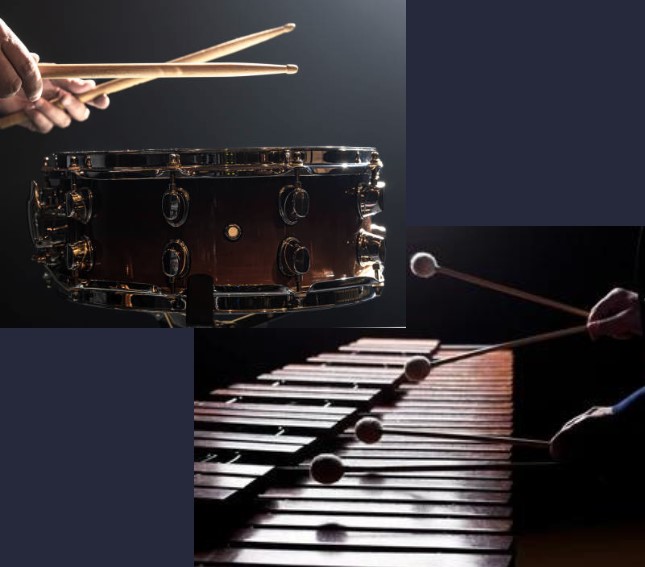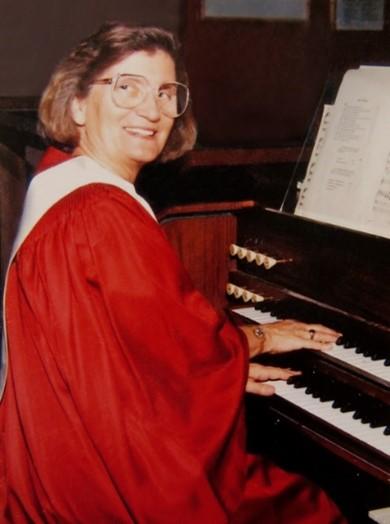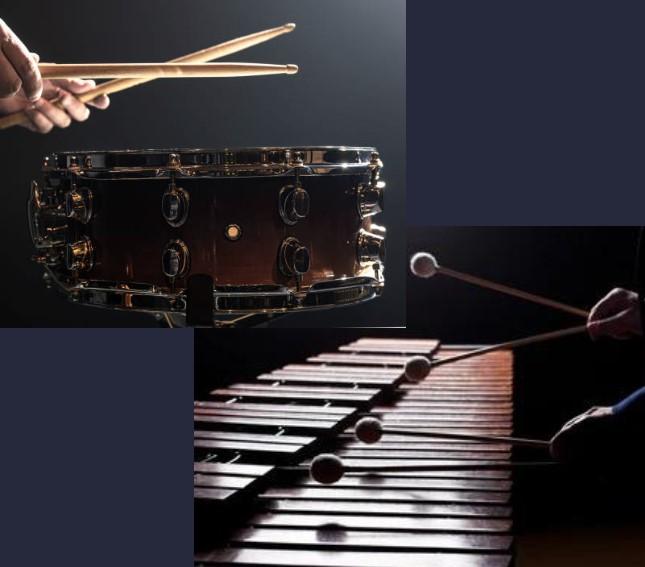Percussion Ensemble: A Centennial Celebration

Time and Location
- 2023, Apr 13 Performing Arts Center 155 - Concert Hall
Disability Accommodations
For disability accommodations, please contact the department presenting the event. Disability access information is available online at Parking Services, and further resources can be found by contacting Western's Disability Access Center.
Western Washington University Percussion Ensemble
- Jacob Anderson
- Alex Bower
- Mica Della Sala
- Daniel Furry
- Micah Hays
- Davis Juneau
- Luke Kane
- Monica Morton
- German Navarrete
- Brady Nehls
- Alex Nelson
- Eli Porter
- Zach Smith
- Lucas Webster
- Jonathan Woods
Concert Program
Triplets for Xylophone and Piano (1924)
George Hamilton Green (1893-1970)
arr. Bob Becker (b.1947)
Lucas Webster, Xylophone Soloist
Tonight’s performance will feature Western’s newly restored Deagan xylophone, originally constructed around 1913. We are immensely grateful to the Stamey Family for gifting this beautiful instrument to our department. You can find the full story behind the xylophone, along with pictures of the family, in our online program notes.
Canticle No. 1 (1940)
Lou Harrison (1917-2003)
Sextet for Percussion (1970)
Zita Carno (b. 1935)
Movement I
Movement III
Clapping Music (1972)
Steve Reich (b. 1936)
Hold Fast (1990)
Casey McClure (b. 1970)
Jonathan Woods, Graduate Director
DDT (2014)
Libby Larsen (b. 1950)
Pyroclastic Steam (2013)
Dave Hall (b. 1983)
Triplets for Xylophone and Piano (1924)
by George Hamilton Green (1893–1970)
Arranged by Bob Becker (b. 1947) for xylophone and marimba accompaniment (1990) Lucas Webster, xylophone soloist
George Hamilton Green was an acclaimed piano prodigy and xylophone virtuoso of the early 20th century. His “Triplets” was one of six novelty fox-trots published under the title of “George Hamilton Green’s Jazz Classics for the Xylophone.” This arrangement was completed in the 1970s by Bob Becker for NEXUS, one of the oldest professional percussion ensemble groups in North America. Becker sought to remain true to Green’s original publish version, only adding dynamics, slurs and accents for clarity. Our performance of this rag, complete with sound effects and timekeeping on the drum set, fully embodies the peppiness, frivolity, and syncopated styles of 1920s popular music.
Tonight’s performance will feature Western’s newly restored Deagan xylophone, originally constructed around 1913. We are immensely grateful for the Stamey Family for gifting this beautiful instrument to our department. Please enjoy their story on the xylophone below:
In the 1920’s, our grandfather, Conrad Sofus Knudsen, born in Norway in 1881, was a percussionist in Fairbanks, Alaska, then known as the Yukon Territory. He played mandolin, the xylophone, and drums and met our grandmother there, who had come from North Dakota to teach in Fairbanks. They married in Tacoma and settled in Seattle after purchasing a five and dime store with a soda fountain on Aurora Avenue. It was there they raised their two daughters.
We do not know the history of where or how our grandfather acquired this instrument. Our mother, who learned the love of music from her father, chose to keep her father’s xylophone. It was present in the family home as we grew up, but despite piano training, no one played it. Eventually, it was moved, to Hillsboro, Oregon in hopes a grandson would play it. In 2019, it returned to Seattle, and was boxed in pieces and stored.
In 2020, Patrick Roulet, Professor of Percussion at WWU was contacted. Those boxes were delivered to him in hopes of restoration and use. The xylophone was manufactured by the “Stradivarius” of xylophone makers, J.C. Deagan in Chicago around 1913 during the golden age of the xylophone. The restoration was done in Chicago by Century Mallets located in the original JC Deagan building. The wood is a very dense Cocoa Bola from Cuba that Deagan marketed under the name, “Klyposerus.” The original wood has been retained and most of the original metal was then replated.
Our mother, B. Janice Stamey (1928-2021), received a degree in Music and Organ Performance from the University of Washington, taught music in Hawaii and Seattle, as well as piano to her five children. She mentored many young musicians throughout her career as a talented pipe organist and pianist. We are so pleased that Western Washington University can enjoy this instrument for many years to come. For the Stamey family, gifting the xylophone to a school of music is a fitting tribute to our mother and grandfather.”
-The Stamey Family
Joan Stamey Cottingham, Virginia Stamey Johnson, Sara Stamey, Alison Stamey, Paul Stamey
A Special thanks to Thomas Harris for suggesting WWU as a home for the instrument and to Sara Stamey and Winston Saunders, Microsoft, and Intel for contributing to the instrument’s restoration.



Canticle No. 1 (1940)
by Lou Harrison (1917–2003)
Lou Harrison was a modernist composer and musician who contributed significantly to the early development of the percussion ensemble genre. In the 1930s and 40s, Harrison worked as an accompanist for modern dance companies on the West Coast. Having taken a world music course with avant-garde composer Henry Cowell, Harrison developed a fascination with global sounds and timbres and sought to explore their potential in percussion works that could accompany modern dance productions. Because of Harrison’s affiliation with collegiate modern dance departments, spaces dominated by women at the time, most of Harrison’s percussion ensemble pieces were performed by female dancers or musicians who exhibited immense interest in percussion yet had no professional training. Canticle No. 1 is no exception: the piece was premiered at Mills College on July 18, 1940, by the Cage Percussion Players, a chamber group consisting of Harrison, John Cage, Xenia Cage (John’s wife and avant-garde painter), Margaret Jansen (a pianist from the Cornish School in Seattle), and Doris Dennison (a Cornish dancer who taught eurhythmics and rhythmic analysis courses). The work maintains a moderate tempo throughout and follows a simple formal structure, aptly demonstrating Harrison’s preference for timbral ingenuity and collaborative music-making over technical complexities.
Sextet for Percussion (1970)
by Zita Carno (b. 1935)
Movements I and III
Zita Carno was a professional pianist and composer who was introduced to percussion in the late 1950s through Paul Price, a percussionist, pedagogue, and percussion ensemble director who established one of the first accredited percussion ensemble courses in the country at the Manhattan School of Music. At the time, Carno was pursuing a one-year master’s degree in piano performance but soon became heavily involved in the percussion program and decided to stay at Manhattan to pursue post-graduate work under Price. Although she was trained as a classical pianist, Price taught Carno how to play various percussion instruments and included her in many performances and recording sessions. In addition to performances, Price also encouraged Carno to compose pieces for his percussionists, resulting in her 1960 Sextet for Percussion, which would later be published in Price’s own publishing company, Music for Percussion, in 1970. The instrumentation of the Sextet features an equal array of pitched and non-pitched percussion instruments, reflecting Carno’s ability to combine what she learned from Price with what she already knew about keyboard instruments as a pianist. This work is a culmination of her percussion experiences in the late 50s and early 60s, uniting her classical interests with newer jazz-like ideas.
Clapping Music (1972)
by Steve Reich (b. 1936)
Following the establishment of accredited percussion courses at institutions of higher education around midcentury, the first generation of professionally trained percussionists in the United States began to form professional chamber groups, compose and premiere a variety of new works, and explore percussive traditions from around the world. One of the most famous of these individuals is Steve Reich, who composed various works for percussion-dominant ensembles in the 1970s that featured phasing techniques, minimalist performance methods, and/or rhythmic sequences influenced by West African drumming genres and Indonesian gamelan traditions. In Clapping Music for two performers, an apt example of the composer’s aesthetic preferences at the time, simplifies the concept of phasing, instead relying on shifting eighth-note patterns to create layers of rhythmic complexity: one performer claps the same rhythm throughout the piece while the other shifts one eighth note over every 8 measures to create different patterns. Tonight’s performance will feature an even number of percussionists on both the unchanging and changing parts, coupled with choreography that serves to prepare the listener for each interlocking rhythmic sequence.
Hold Fast (1990)
by Casey McClure (b. 1970)
Directed by WWU Percussion Graduate Student Jonathan
Hold Fast is a large, conducted percussion ensemble work that exemplifies newer trends in the genre around the turn of the 21st century, particularly the increased use of keyboard percussion instruments to provide a greater sense of tonality through intricate melodic lines and chordal sequences. The title is a literal challenge to the listener to "hold fast" to the underlying rhythmic pulse established in the first sections of the work. This pulse is slowly usurped by changing meters and unequal divisions of the measures. Each section highlights different combinations of the wood and metal instruments while maintaining the integrity of the original melodic and rhythmic ideas.
DDT (2014)
by Libby Larsen (b. 1950)
DDT is the recipient of the John Beck Composition Prize for the 2014 Percussion Rochester at Greentopia Festival, with the generous support of the Goldberg Advised Fund of The Foundation of the Jewish Federation of Greater Rochester. It was premiered by NEXUS in 2014. The work demonstrates not only stylistic and aesthetic characteristics of contemporary percussion chamber works, but also the role music can play in the struggle for environmental justice. Larsen described her composition in the following manner:
DDT is inspired by Rachel Carson’s environmental manifesto, Silent Spring (1962). The book raises important questions about humankind’s impact on nature. Carson asks us, a civilized nation of intelligent people, a question that is not only scientific but moral. “The question is whether any civilization can wage relentless war on life without destroying itself, and without losing the right to be called civilized.”
My original thought for this piece was to translate passages of Silent Spring into Morse code and essentially read the book aloud by way of the percussion instruments. I discovered that instead of reading the book, I would be spelling the book and this would take hours, if not days, to do. Instead, I translated eleven words into Morse code and composed a manifesto on Carson’s book: Air, H20, Bird, Insect, Wonder, AH, Human, Drill Baby Drill, STOP
Pyroclastic Steam (2013)
by Dave Hall (b. 1983)
Pyroclastic Steam was commissioned by Russell Ratterree and the Wylie Percussion Ensemble for their showcase concert at the 2012 Percussive Arts Society International Convention. In tonight’s program, the piece serves to exemplify the most contemporary subgenre of percussion ensemble repertoire, the percussion orchestra, which is a large, keyboard-centric work for 8 or more players that is tonal, virtuosic, and aggressive. Hall wrote the following about the work:
Pyroclastic Steam was inspired by a 2012 trip to teach percussion at Kamehameha Schools in Honolulu, Hawaii. The beauty of the islands along with their seemingly improbable and precarious location in the middle of the Pacific sparked my interest in the volcanic origin of the islands, and in volcanoes in general. The piece is composed of four parts: Eruption, Aftermath, Synthesis, and Epilogue. In the first three sections, the music depicts the violent process of the islands' formation from molten lava to rock. The ensemble represents the different physical states of matter, moving from liquid to gas to solid.
While the first three parts are set in distant past before anyone inhabited the islands, the Epilogue is set in present day, and is based on very specific memory I have of my time there. Before each meal the students would gather to sing the doxology in Hawaiian outside of their cafeteria (which happened to be perched on top of a mountain). As I looked out at the island and listened to the austere beauty of their music, it seemed that the surroundings (the ocean, trees, and some nearby birds) were singing along with them. Standing on rock that was once fire, I was struck by the beauty of the present moment, all made possible by some of the most violent forces of nature imaginable.



